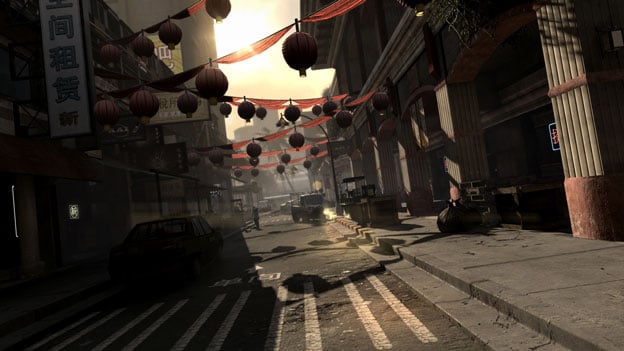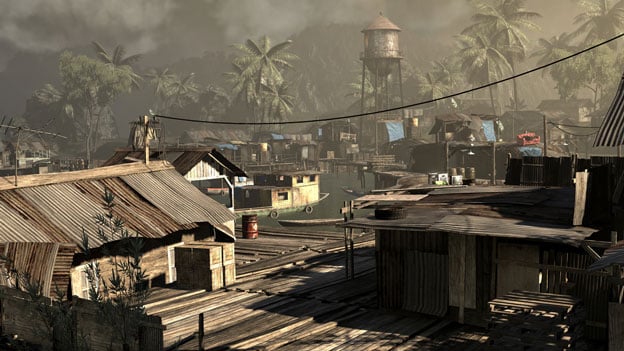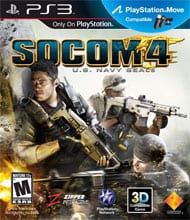SO-COME ON!
When the original SOCOM: US Navy SEALs came out, it was an interesting concept. The game was as meticulous as it was methodical, and instead of rushing in guns blazing—which would assuredly get you killed in a very Counter-Strike style manner (read: quickly), you had to plan your every move, switching between members of your covert ops team in order to strike with the best laid plans.

If you played it right, which admittedly wasn’t all that easy because of the AI’s tendency to disobey orders or give away positions, a seasoned strategist could take down a whole map of enemies in a just a few minutes. Naturally the developers have had to cut away from that slower, Rainbow Six-like approach over the past several years, in order to stay current with market trends. Real life accounts of war, which often detail days of unyielding boredom, punctuated by moments of intense panic, fear, and violence when one’s life may actually be in danger, are so far from the norm of what’s expected in our “realistic” depictions of it in video games that the original SOCOM would never hold the attention of gamers who have been raised to expect an explosion or a gun battle going off every few minutes. So it is that SOCOM 4 manages to—quite easily, in fact—lose itself in an already overcrowded market.
To put it lightly, SOCOM 4 is a mess. It’s obviously trying to be Call of Duty, which is understandable because every military-minded game has to be if they want to stay commercially relevant. But in doing so, SOCOM 4 just feels like a rehash of a game you’ve already played a hundred times before, and it doesn’t even handling rehashing well. As it is, the game is still a tactical shooter, albeit one that’s not up to date with modern game standards. It has the basic shell of a cover shooter, though you can’t always blind fire or slide into cover with ease. You still have two “teams” of two people each that you can direct and lead, or order to concentrate fire on a particular enemy, but they still don’t listen to you half the time. Stealth and planning are no longer an option (except in non-combat missions), meaning you have to send out very basic tactical orders on the fly with no real way to effectively pre-plan an assault. Even if you could lay it all out in advance, it wouldn’t really matter, since you have to end up unrealistically playing commando anyway. At least that’s what regenerating health is for, right?

I’d be willing to accept these changes to the series formula more if the game’s AI and related-programming weren’t so woefully inept. Your two teams, blue and gold, specialize in mid-to-short range assault and mid-long range sniping and covert ops, respectively. The distinction is nice, since you can in theory, say, send blue to a flanking position on the battlefield while target units directly by tapping the “issue gold orders” button when your reticle is on an enemy. However, blue won’t get there half the time (or they just disappear) and if you’re a few pixels off target, you’ll send the seemingly armor-light gold marching straight to their doom by mistake, since target and directing a team to a particular location is handled with one button each. Other times you’ll tell your team to flank either side of a battlefield, only to have the AI baffled as to what you mean.

There’s a particular instance around halfway through the game where your squad is being attacked by pinpoint accurate bombardments from a docked stealth frigate. The only way to get close enough to the frigate to plant C4 on it was if I sent out teams a distraction, so from the protection of the only piece of centrally-located cover, I issued my orders, repeatedly. “No can do, sir,” one of my team said. The sentiment was echoed in various other facets. Moving backwards and issuing the orders again did nothing. Either the AI was too stupid to realize that I wanted it to move to another position, or Zipper imbued my bot pals with an annoying sense of Darwinism. Either way, I had to move everyone together to the side following close behind me until I could once again tell them to draw the attention of the massive battery laying waste to the map (all this with plenty of enemy soldiers around, who are somehow never caught in the shock of the massive explosions hitting the battlefield as they continually assault your positions). This sort of occurrence is not infrequent, meaning you’ll probably mostly abandon your ineffective teammate’s skills to play the game like every other third-person shooter. And when you’re willfully ignoring key design components, that’s a big problem.

To break up the monotony of shooting bad guys repeatedly, the game occasionally throws you stealth missions in which you play a female covert operative. This is a nice idea, but once again, SOCOM more or less falls on its face here. The stealth itself works fine—in fact in order to keep up the pacing and difficulty, it’s a little too easy. That’s exactly the problem: enemies are so unbelievably brain dead it completely saps these segments of any sort of urgency or risk. It’s probably no shock when I say that Metal Gear Solid 4 is the only stealth game this generation that even comes close to realism in both sneaking and AI, where more often than not you were quickly forced to abandon stealth entirely given the merciless way that if you so much as moved just a little too quickly behind a guard you were discovered. In SOCOM 4, enemies are so dumb they don’t even hear you crawling in overgrowth two feet in front of them. And why do guards always muse to themselves out loud that it must just be their imagination? I guess the lowest-tier henchmen of every video game come from the same factory of defective morons.
There are a few nice things about SOCOM. The shooting, for what it is, is mostly competent, and despite issues following commands, your AI teammates will actually make a dent in enemy numbers. The multiplayer modes add some fun mechanics, like bomb squad defusing, making this more interesting than the single player game. Bear McCreary’s score is also actually pretty good, though it may lean a little heavily on a couple of musical motifs. And, because not every military shooter can be about WWIII with Russia or Korea, it’s very refreshing to see a game where the heroes’ primary objective is as comparatively mundane as protecting a vital shipping lane in East Asia. How’s that for realism? Still, SOCOM 4 is mostly forgettable.
RATING OUT OF 5 RATING DESCRIPTION 3.8 Graphics
Not a stellar looking game, but SOCOM is certainly competent. 3.5 Control
Control is your standard third-person shooter scheme, though the AI often won’t listen to your orders. 3.0 Music / Sound FX / Voice Acting
Music and voice acting are good, though the sound mixing is way off. 2.3 Play Value
The problem with a game like SOCOM is that it can’t fully commit to either its tactical roots or the more action-oriented demands of industry trends—the result is less interesting than the sum of its parts. 2.5 Overall Rating – Average
Not an average. See Rating legend below for a final score breakdown.
| Review Rating Legend | |||
|---|---|---|---|
| 0.1 – 1.9 = Avoid | 2.5 – 2.9 = Average | 3.5 – 3.9 = Good | 4.5 – 4.9 = Must Buy |
| 2.0 – 2.4 = Poor | 3.0 – 3.4 = Fair | 4.0 – 4.4 = Great | 5.0 = The Best |
Game Features:
